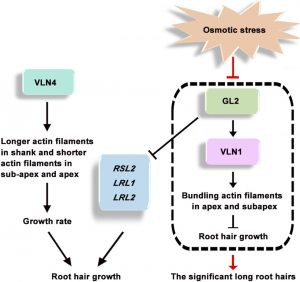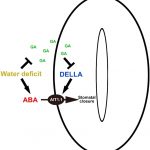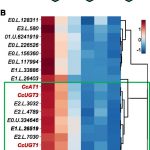Villin and GLABRA2 Regulate Root Hair Growth
 The enhanced elongation of root hairs in response to mild water deficiency permits more effective water and nutrition uptake. The growth of root hairs is regulated in part by actin dynamics. Thick actin-filament bundles (“thick bundles”) in the apical and subapical area of root hairs, for example, are known to inhibit root hair growth. Actin-binding proteins, including villins (VLNs) are believed to be major organizers of the thick bundles in root hairs. Additionally, a series of key transcription factors have been identified as key regulatory factors that influence root hair growth. The transcription factor GLABRA2 (GL2) in particular plays an important role in the initiation and growth of root hairs in Arabidopsis (Arabidopsis thaliana). Several gl2 mutants, for example, have significantly longer root hairs than wild-type. GL2 directly suppresses the function of positive hair growth regulators, including several transcription factors, thus negatively regulating root hair cell growth. Wang et al. (10.1104/pp.20.00480) now show that vln1 mutants display significantly longer hairs with longer hair growing time and defects in the thick actin bundles and bundling activities in the subapical and apical regions. The authors show that VLN1 overexpression suppresses the gl2 mutant phenotypes regarding hair growth and actin dynamics. Moreover, GL2 directly recognizes the promoter of VLN1 and positively regulates VLN1 expression in root hairs. The GL2-mediated VLN1 pathway is also shown to be involved in the root hair growth response to osmotic stress. These results demonstrate that the GL2-mediated VLN1 pathway plays an important role in the root hair growth response to osmotic stress and suggest a transcriptional mechanism that regulates actin dynamics and hence cell tip growth in response to environmental signals.
The enhanced elongation of root hairs in response to mild water deficiency permits more effective water and nutrition uptake. The growth of root hairs is regulated in part by actin dynamics. Thick actin-filament bundles (“thick bundles”) in the apical and subapical area of root hairs, for example, are known to inhibit root hair growth. Actin-binding proteins, including villins (VLNs) are believed to be major organizers of the thick bundles in root hairs. Additionally, a series of key transcription factors have been identified as key regulatory factors that influence root hair growth. The transcription factor GLABRA2 (GL2) in particular plays an important role in the initiation and growth of root hairs in Arabidopsis (Arabidopsis thaliana). Several gl2 mutants, for example, have significantly longer root hairs than wild-type. GL2 directly suppresses the function of positive hair growth regulators, including several transcription factors, thus negatively regulating root hair cell growth. Wang et al. (10.1104/pp.20.00480) now show that vln1 mutants display significantly longer hairs with longer hair growing time and defects in the thick actin bundles and bundling activities in the subapical and apical regions. The authors show that VLN1 overexpression suppresses the gl2 mutant phenotypes regarding hair growth and actin dynamics. Moreover, GL2 directly recognizes the promoter of VLN1 and positively regulates VLN1 expression in root hairs. The GL2-mediated VLN1 pathway is also shown to be involved in the root hair growth response to osmotic stress. These results demonstrate that the GL2-mediated VLN1 pathway plays an important role in the root hair growth response to osmotic stress and suggest a transcriptional mechanism that regulates actin dynamics and hence cell tip growth in response to environmental signals.



